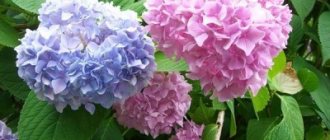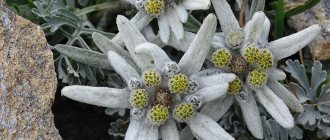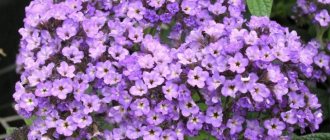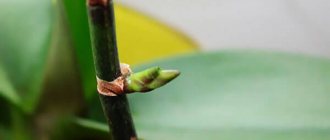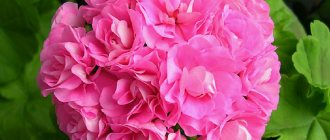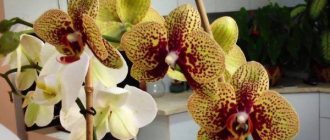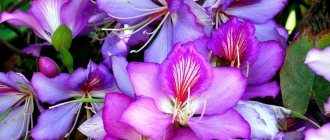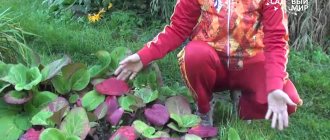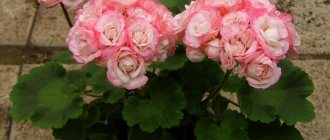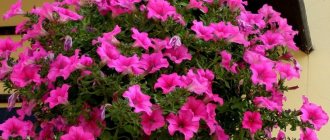Features and names of the plant
The homeland of balsam (Impatiens) is Africa. Or more precisely - o. Zanzibar. The flower came to Europe only in the 16th century. Culture was brought to Russia even later (in the 19th century). But here she has taken root perfectly. Domestic flower growers quickly learned everything about balsam and began to successfully grow it in different regions of the country. The plant belongs to the Balsamaceae family.
Description of the plant:
- balsam has a bush-like shape;
- consists of long (up to 75 cm) juicy, fragile, transparent stems;
- the leaves are elongated, heart-shaped, slightly wrinkled, and are pure green or brownish in color;
- five-petaled flowers are single, axillary, have characteristic spurs up to 5 cm long;
- The color of the flowers is varied: all sorts of shades of pink, red, purple, coral; there are white and variegated ones.
Bud with a spur
The culture is amenable to breeding experimentation. Currently, many varieties have been bred: tall and low bushes, with simple and double flowers, with large and miniature buds.
The special properties of the culture and long history have given it several interesting names:
- "Touchable." It appeared because during the period of seed ripening the plant becomes sensitive to any touch. Even the touch of the wind can cause fruit pods to scatter.
- Flower "Spark". As evening approaches, dozens of flowers of different shades open on the bushes of the plant. It looks very attractive and gives the impression of burning lights.
- "Wet Vanka." During the growing season, small drops of moisture appear on the leaves of the plant. There is a sign that in this way Vanka Mokry signals the approach of rain. This variant of the name is also associated with the constant need of the flower for watering and moisture.
Impatiens can be annual or perennial. This is determined by different ways of planting it depending on the region. In general, the flower, which appeared in the warm tropics, is a perennial. But in colder regions it is planted outside as an annual plant. Then it blooms all summer until late autumn.
Description of the plant and its varieties
Indoor cactus flower
Vanka belongs to the genus balsam, which includes about 400 species of plants. Amateur gardeners mainly grow indoors the following types of balsam:
- Holst.
- Waller.
- Sultansky.
- New Guinea hybrids.
Flowers with a varied palette of shades give the plant a special charm. They can be from light pink to dark red colors. You can also often find balsams, the petals of which are painted in several colors.
Modern breeders are constantly working to develop new plant varieties. So, recently many large flowers have appeared. Moreover, the bushes remain small, which makes it possible to grow them on windowsills.
Plant varieties with double flowers are also popular. Loggias and rooms decorated with such hybrids look great. This indoor plant, thanks to its many bright flowers, looks very beautiful and decorative, as shown in the photo.
Continuing to work on developing new varieties, breeders went even further: they created a plant with variegated leaves. Such a Vanka wet flower attracts people’s eyes even when its buds have not yet opened.
Types of indoor balsam and popular varieties
There are about 400 species of Impatiens plant. The most popular types of balsam (impatiens) are useful for every gardener to study.
There are 4 main ones and several variety series that are popular in indoor culture. The same care is recommended. Basically, variations of the indoor perennial plant balsam differ from each other in appearance.
Waller's touch-me-not
The species stands out for its love of diffused light and sensitivity to touch. The bush can drop all its flowers due to a slight outside touch at a certain period. The plant is compact - usually no higher than 25 cm.
It has sharp oval leaves that are deep green in color. And the appearance of flowers depends on the subspecies. The flowers are quite large, with different variations of double size - from simple to lush roses.
Waller's impatiens, due to its beauty and ease of care, quickly became popular among gardeners. Therefore, breeders began to develop its varieties. This is how new additional varieties of balsam appeared.
Stardust
Stardust is a compact flower with large bright buds. This balsam with pink flowers is especially popular. They are large in size, bright pink with a slight white dusting on the petals.
Snow-white underside of the buds. The variety is distinguished by its resistance to pests. For example, he is not afraid of ticks.
Kandy
Balsams of the Kandy series were bred and went on sale not so long ago. The bushes of the plant consist of smooth and succulent stems, petioles with elongated oval leaves (their tip is pointed).
The culture blooms abundantly, the buds are bright, the flowers bloom simple and are located on high stems. The flowers are soft to the touch, with a delicate velvety surface. The variety is not demanding in care.
Tropical
Impatiens flowers of the Tropical variety are semi-double, beautiful with unusual colors. They are found in colors ranging from salmon (delicate) to bright coral.
This is a very popular variety in modern floriculture. It is more demanding in care than previous options, but also does not require special conditions. You can simply grow the crop on a windowsill in a small pot.
Fiesta
Terry balsam Fiesta is considered a universal species for indoor growing. Famous for its large, bright flowers in many shades.
The petals of the plant are terry and pleasant to the touch. The variety is easy to propagate. To do this, cuttings are cut throughout the season, which take root well at home.
New Guinea
Hawker's balsam, which grows wild in New Guinea, has become the source plant for the development of several varieties, which are called New Guinea hybrids. The culture has large flowers that bloom almost all year round. The elongated oval leaves have a rich color, often dark.
The plant is fast growing and larger than Waller's impatiens. It first appeared in Europe at the end of the 16th century and has not lost its popularity among gardeners since then.
Niamean
Niamey balsam has unusual flowers, shaped like beans. They can be yellow, red or two-color.
The variety is undemanding to lighting - perfect for growing in any window. During the period when the plant is not blooming, you can even place it in a shaded corner. And for high-quality flowering, it will already need a sufficient amount of light at least 4-5 hours a day.
Orchidaceous
Orchid balsam is an unpretentious indoor variety. It has a brittle deep pink stem with large green velvety leaves.
The main thing in caring for this variety is to water the flowers regularly, since they cannot tolerate either drying out or waterlogging of the soil.
Indoor flowering plants with a wide variety of varieties: indoor begonia, pelargonium, indoor gerbera, fuchsia.
Varieties
There are about five hundred species of balsam. The most popular in breeding include the following.
Waller's balsam (Waller's balsam)
This species has earned popularity for its variety of flower colors, which make it possible to create magnificent flower beds and even vertical gardening in garden conditions.
When grown in the garden, it is classified as an annual plant, as it dies at the slightest frost, so you need to prepare and root cuttings in time for planting next year.
Waller's balsam grows up to fifty centimeters in height and has thick, juicy and spreading shoots. The small, egg-shaped leaves can be green, red or variegated. Flowers of simple, double and semi-double form have about twenty shades.
If you want to know how to properly plant purslane and care for it, read about it in the article.
Have you decided to decorate your garden with oleander? Read about its planting and care.
Garden balsam (Impatiens impatiens)
Garden balsam is a low annual plant (up to seventy centimeters). Flowers can be white, pink, red and even blue. Long flowering begins in June and ends in late autumn. This type of balsam is often used to decorate borders.
Balsam sultanoid
This species is an annual in garden conditions. It is distinguished by its highly decorative leaves. They have a white-yellow center with reddish veins and green edges. The large flowers are usually bright pink or red.
Iron balsam
Iron balsam is very different from other varieties. This is a plant with a thick succulent trunk that can reach two meters in height.
Long and thin peduncles are topped with flowers with two petals and a calyx. Their color varies from white to purple. This species is well adapted to growing in summer cottages and is usually used to decorate flower beds. Flowering lasts until the onset of frost.
Admire photographs of the most popular types of balsam:
How to care for balsam at home
Any varieties of indoor balsam flowers are not picky to care for. An excellent option for beginning creators of home plant collections. The main thing is to understand the basic important conditions (features of lighting, watering, fertilizing, transplanting). Proper planting and care will allow the gardener to become the owner of a lush, beautiful, bright flower.
Illumination
Responsible care for balsam necessarily includes choosing a place for the flower in the apartment and lighting. It is best to place the pot with the plant on the window sill on the south side. At first, on sunny days, young bushes are covered with light curtains to prevent burns of the foliage. In very hot summers, it is advisable to move the flower to a western or eastern window sill. And during the rest of the year there is no point in protecting the plant from sunlight. The crop will not bloom in a very dark place. And light partial shade will be beneficial - the flowers will be brighter.
If the plant begins to stretch upward and the lower leaves fall off, this is a clear clue that the pot is located in the wrong place. In this case, you can wait for flowers only at the very top of the bush. It is necessary to choose a more comfortable place for the balsam and observe its behavior.
In the summer, it is recommended to place the flower on the balcony or outside so that it receives direct sunlight and fresh air. It is only important to ensure that the plant is not damaged by rain and wind.
Temperature
Indoor balsam loves warmth. In summer it is comfortable to grow at temperatures from +20 to +28 degrees. In winter, this figure can be reduced. It is optimal to maintain the room temperature at least +16 degrees. In the cold, the lights do not bloom and begin to slowly die.
Watering
When caring for balsam at home, it is easier to regulate watering than when growing it in open ground. The flower loves water, but it cannot be flooded. The soil in the pot should be constantly moist. For watering, it is worth preparing a bottle of water a day in advance so that it has time to settle. In summer, balsam needs a portion of water daily or every other day. In winter, the amount of watering is reduced by about 3 times.
It is necessary to regularly assess the condition of the soil in the pot. As soon as it dries 1 cm deep, the plant urgently needs watering. If a white coating is noticed on the surface of the earth, it should be softened and the alkalization process should be stopped. To do this, the top layer of soil is removed and a new one is filled in.
Top dressing
Fertilizers should be applied to pots with balsam from mid-spring to late autumn, repeating the procedure 2 times a month. In this case, special mixtures for fertilizing are selected, formulated for indoor flowers. They must contain potassium and phosphorus.
Terry balsams require nitrogen mixtures less often. They are introduced into the soil in the spring, as this speeds up the process of foliage growth. Excessive amounts of nitrogen can harm the plant. To determine the portion of such fertilizer for balsam, you should divide by 2 the amount recommended in the instructions for it.
Transfer
Balsam is one of those plants that should not be grown for years, replanting it annually in a new pot. Young bushes that are looked after for one or two seasons look more attractive.
But replanting will still be necessary when caring for indoor balsam at home. The bush grows and from month to month the nutritional value of the soil in the pot decreases. As a result, the leaves begin to fall off, the stems become elongated, and the flower looks and develops worse.
Transplanting the crop into a new pot will help avoid this. It should be more spacious so that all the roots of the plant and a small portion of fresh soil can completely fit in it. Excess shoots can be cut off during transplantation.
When moving the balsam into a new pot, it is carefully transferred along with the earthen lump. This should be done as carefully as possible so as not to damage the roots.
Afterwards, the plant is watered and a fresh portion of soil is poured into the container. The balsam will bloom again when it adapts to new conditions.
Indoor light flower how to care
Touch-me-not, evergreen, light, Vanka wet flower - all these are names for one plant, which is quite often found in our apartments. The homeland of this pretty flower is tropical Asia and Africa. It is one of the most unpretentious and easy plants to grow at home.
Ogonek takes root easily, grows quickly and looks very impressive during flowering: its compact bushes, strewn with bright flowers, can decorate any room. The Vanka wet flower also has another name - balsam. With good care, it can bloom almost all year round, and providing it with favorable conditions is not difficult.
Even a novice gardener can easily cope with growing this plant. It is perennial, but due to its rapid growth, the shoots usually become elongated, the bush becomes spreading and quite soon loses its compact shape. Therefore, balsam lovers often take cuttings from old plants in the spring, growing new bushes.
Impatiens bloom better if planted in a slightly cramped pot or container. A plant in a pot that is too spacious will not bloom lushly.
Description of the plant and its varieties
The genus impatiens includes about four hundred species of plants. In indoor floriculture, they mainly grow:
- Holst's balsam;
- Sultan's balsam;
- Waller's balsam;
- New Guinea hybrids.
Wet Rolyflower flowers come in a huge variety of shades: from white and soft pink to red and dark burgundy. Plants with two-color petals are becoming increasingly common. Recently, breeders have developed varieties with flowers much larger in size than the usual indoor balsams. At the same time, the bushes of such plants are still compact.
Given the popularity of balsam for growing indoors, breeders continue to work on creating new varieties. The hybrids that have appeared recently are striking not only in the size of the flowers, but also in their color and shape. Varieties with double flowers have already become quite common, which look great in landscaping rooms and balconies.
Impatiens bushes, densely strewn with bright flowers, are very decorative. However, this was not enough for breeders, and varieties with beautiful variegated leaves appeared. Such plants look very attractive even at a time when the flower buds have not yet bloomed. This can be seen in the photo of wet Rolyflower with variegated leaves.
Variegated varieties need to be created in the same conditions as ordinary ones. They require the same care, with only one difference: in winter, their temperature should be higher than for plants with solid green leaves.
Balsam propagation
The Vanka wet flower propagates in spring and summer. Two methods are suitable for its propagation: seeds and cuttings. You can purchase ready-made seeds or get them yourself from your home plant, but to do this you need to take care of its pollination. The seeds germinate within two weeks.
Rooting of cuttings requires approximately the same time. As you can see in the photo, a wet vanka indoor flower can easily take root in water. 3-4 pieces of charcoal should be placed in the water for rooting cuttings. Side shoots of a plant about 8 cm long are suitable as cuttings.
Balsam propagation
The culture is propagated in two ways: cuttings and seeds. In the first case, the plant takes root very quickly. And in the second, you need to create a more complex soil mixture for the flower.
Propagation by cuttings
Indoor balsam is most often propagated by cuttings. In the process, it is enough to cut off part of the stem (7-8 cm), remove the lower leaves and send it into the water. Place the cutting in a glass in a warm and bright place. In about 8-9 days it will take root.
The soil mixture must be prepared consisting of five components in equal proportions: turf soil, leaf soil, humus, peat, sand. The soil should be loose and nutritious.
It is better to plant cuttings in pots several at a time - this will allow you to get a lush bush. A full flowering plant should be expected in a few months. All qualities of the mother variety are preserved.
Growing from seeds
When growing balsam from seeds, you will need to mix 1 part perlite and 2 parts peat. Flower seeds are scattered over the mixture, covered with a thin layer of earth and sprinkled with water. They are left under glass for the duration of germination at +22-25 degrees. It is important not to overwater the seeds. The best time to sow seeds is January.
Reproduction
Balsam is propagated by both seeds and cuttings.
Seeds
Balsam seeds are very small, their germination lasts up to eight years. In order for balsam to bloom in early summer, you need to sow seeds for seedlings in January. Seeds should be treated with a solution of potassium permanganate (ten minutes), and then placed in a solution of a growth stimulator for several hours.
For planting, you can take a ready-made soil mixture for seedlings or peat and sand in equal quantities. The seeds are evenly distributed over the soil, lightly sprinkled with sand and moistened. Boxes with plantings are covered with polyethylene film or glass and placed in a room with a temperature of at least twenty degrees. The cover is removed daily for ventilation and watering.
Shoots usually appear two weeks after planting. After two true leaves appear, the seedlings are picked into separate small pots (up to ten centimeters in diameter). Pinching is done when the seventh leaf appears to make the plants more lush and decorative.
At the beginning of May, seedlings should begin to be taken outside during the day for hardening. This will help the plant quickly acclimatize after planting. Planting in open ground is carried out in the absence of a threat of frost. The distance between plantings should be at least thirty centimeters.
Flowering of plants grown from seeds begins three to four months after sowing.
Cuttings
For cuttings, shoots of healthy, well-developed plants are used. Propagation is carried out by apical cuttings no more than ten centimeters long. This can be done at any time of the year using soil, sand or water.
After complete rooting occurs, the cuttings are transplanted into individual pots with properly selected soil.
Diseases and pests
Yellowing, falling or wilting of balsam leaves indicates a possible disease. A long absence of flowering may also indicate this.
The flower can be bothered by whiteflies and spider mites. Pests attack the flower in insufficiently ventilated or too hot rooms. Special traps - sticky tapes hung over the pots - will help to partially cope with them. You also need to regularly clean whitefly eggs and larvae from the leaves and spray the plant with insecticidal solutions.
Moist and fresh air will drive away ticks from the balsam. The simplest and most effective measure is regular spraying of indoor flowers. The mite is afraid of humidity, while the balsam is moisture-loving.
If moss or mold is noticed on the ground in the pot, the top layer is removed and thrown away. This part is replaced with a new nutrient mixture of soil and sand.
Fading leaves and signs of rotting of the root system indicate that the soil in the pot urgently needs to be changed. The indoor flower is removed from the container and the roots are washed. The new soil should be water- and breathable, loose. If the root system is already severely damaged, then you will have to take cuttings from the plant.
Possible growing problems
When caring for balsam at home, various problems may arise. So, in winter, a flower often freezes if it is located close to the glass of a window. In this case, it should be moved further away and placed where the plant receives heat from the radiator.
It happens that balsam leaves begin to lose moisture in the summer and dry out. In this case, you will need to measure the humidity in the room. It should remain within 40-60%. Even without special humidifiers, it can be raised to such levels by regular spraying from a spray bottle.
Balsam has many varieties, each of which has its own special advantages. Among them, any gardener will find the ideal option for himself. With minimal proper care, the plant will delight its owner with bright, beautiful flowers for many months. Impatiens is included in the Top flowering indoor plants.
What is a swimsuit used for?
In addition to the beautiful flowers, frying flowers are used as an excellent medicine for swelling, bruises, wounds, skin lesions, and tinctures are also prepared from it to treat the liver and other diseases. This is because the leaves and flowers contain a large amount of vitamins, minerals and other beneficial substances. Both the leaves and flowers of the plant are used in medicine.
The lights look very beautiful on alpine slides, mixborders, and flower beds. They look especially interesting in combination with some other herbs, flowers and landscape elements.

